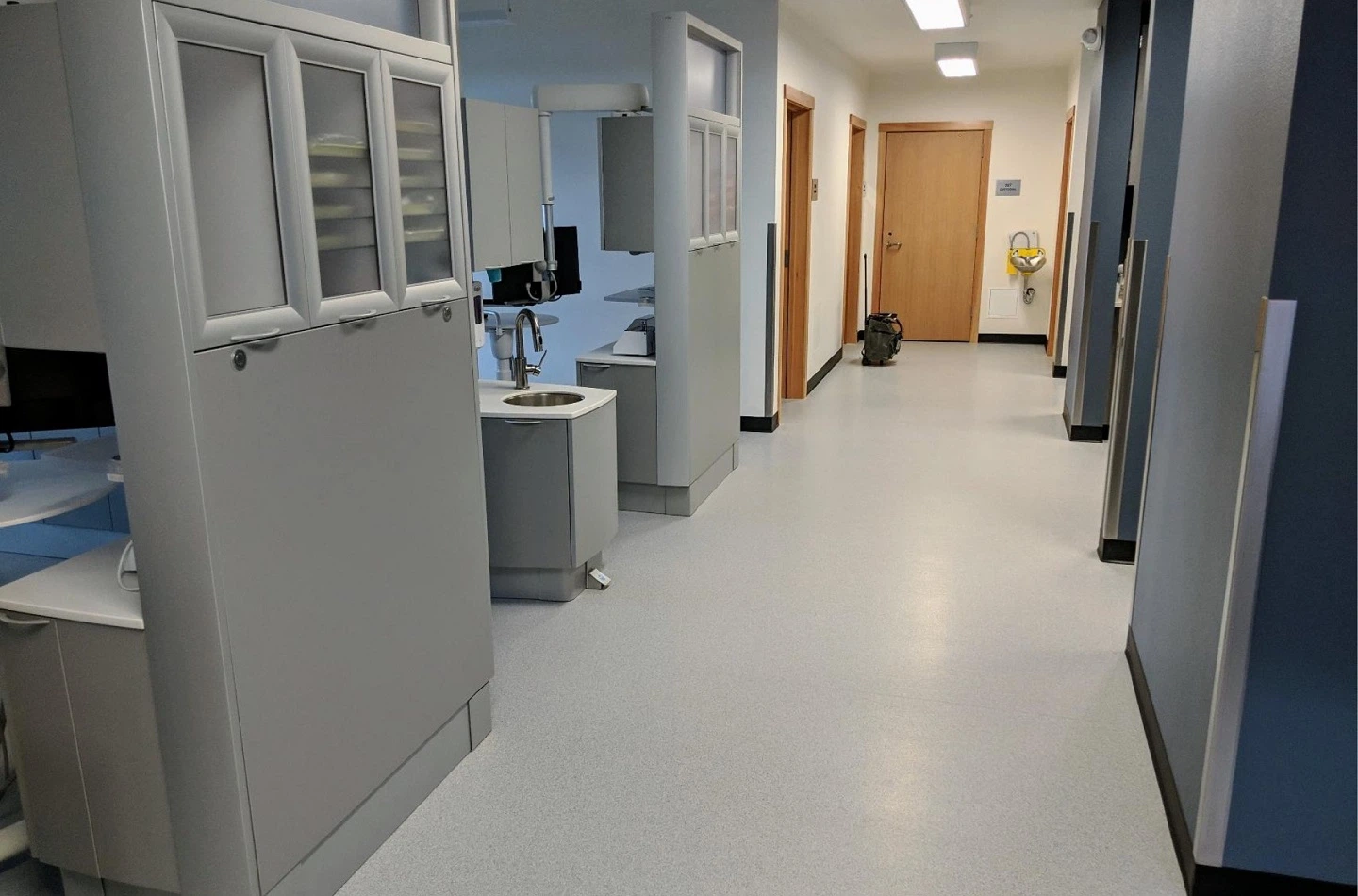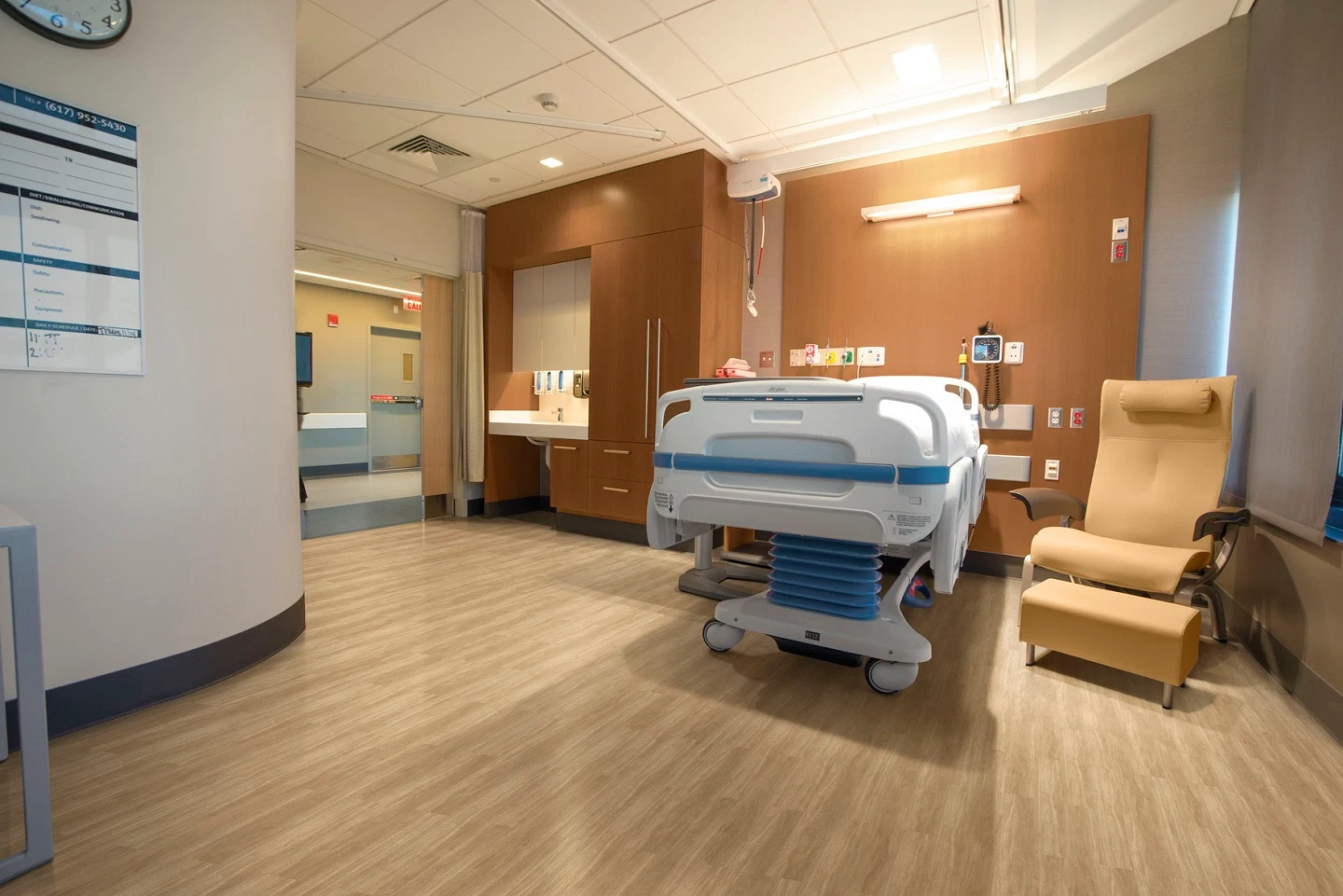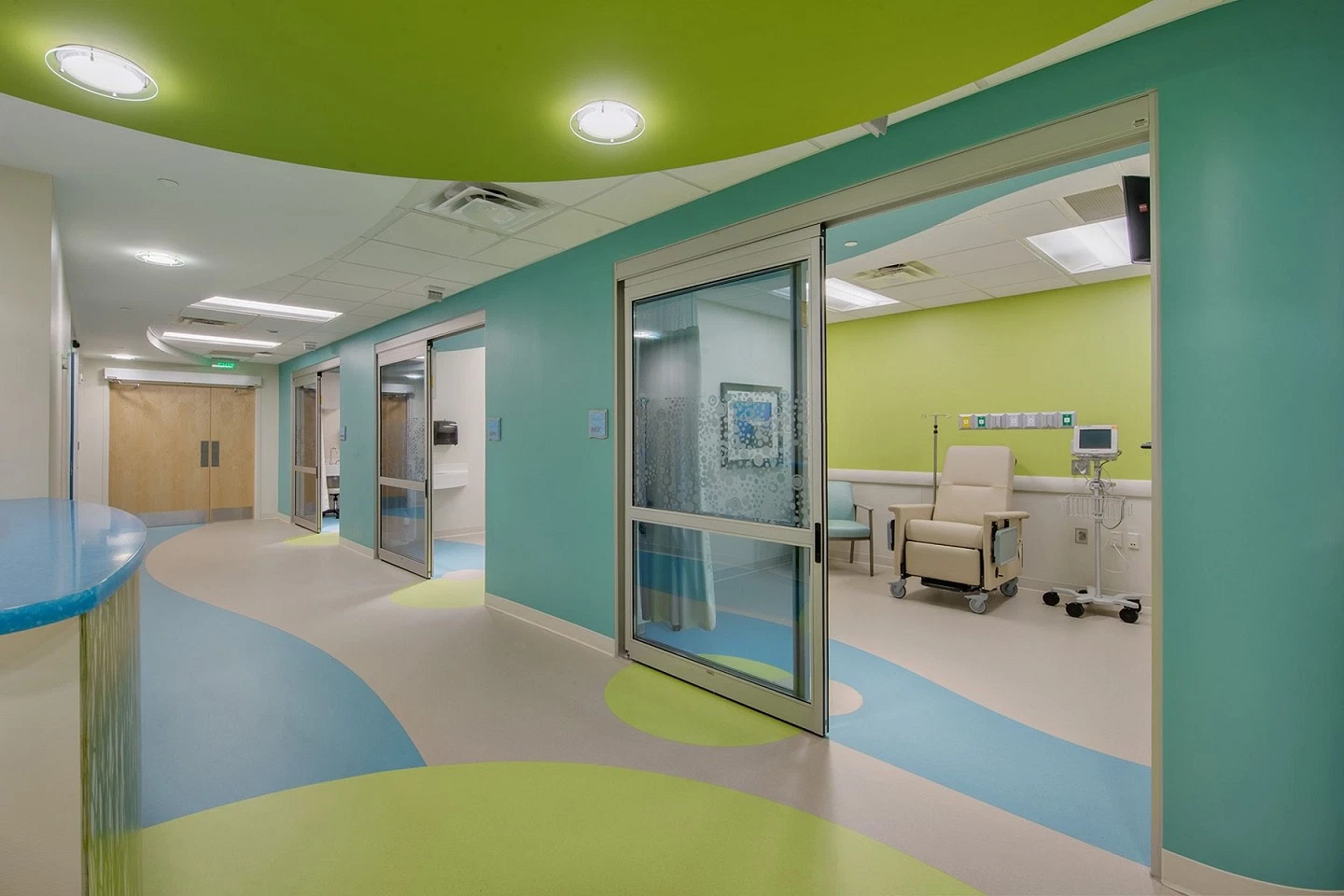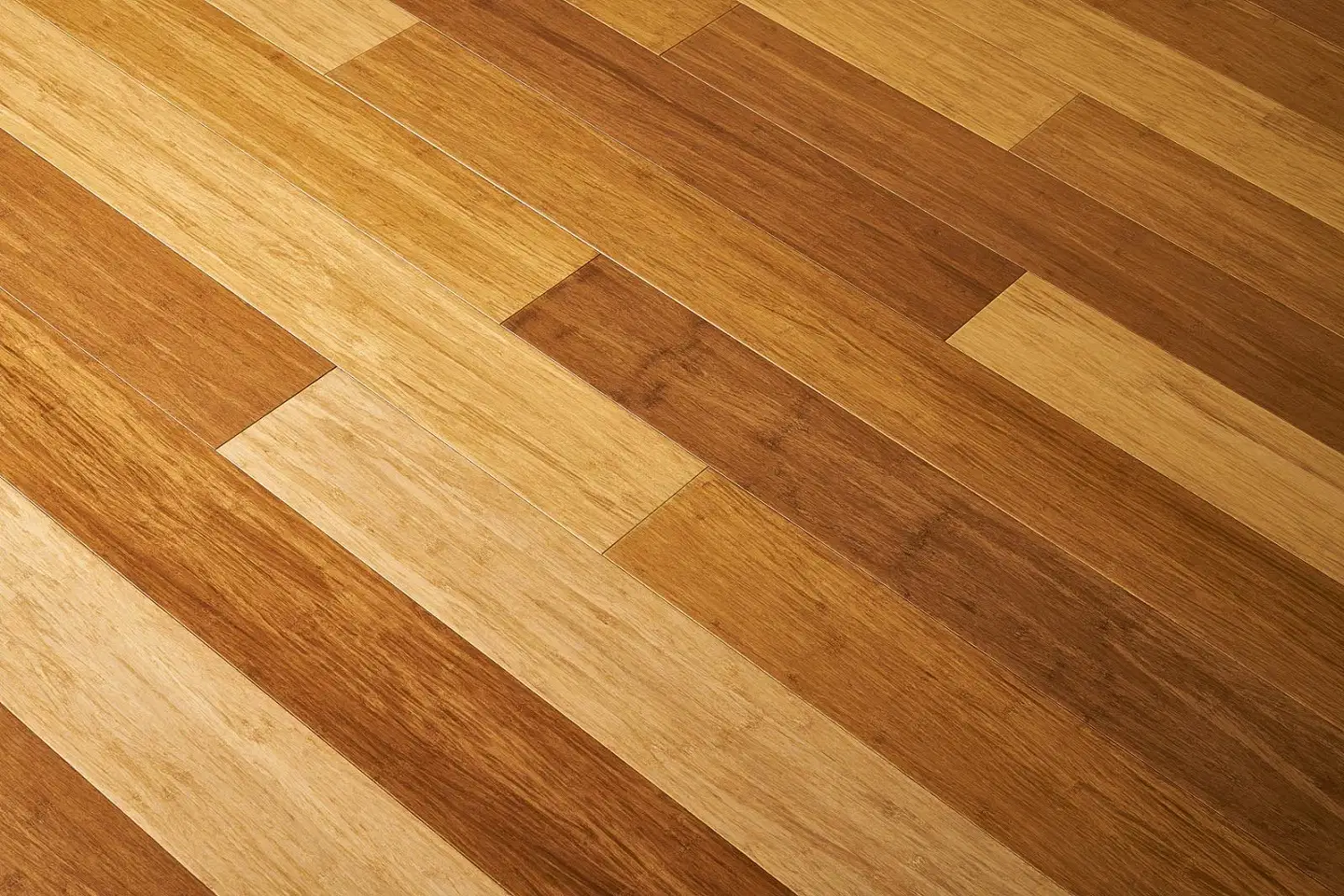Hospital Flooring: Elevating Healthcare Environments With Thoughtful Choices

Even the smallest details in healthcare contribute to the bigger picture of patient care. Flooring is no exception. From corridors to patient rooms, the right flooring choice can significantly impact comfort, hygiene, and aesthetics.
Join us as we explore the world of healthcare flooring. We’ll discover different flooring types like Luxury Vinyl Flooring (LVF), Vinyl Composite Tile (VCT), Sheet Vinyl, Rubber Flooring, Bamboo Flooring, and Commercial Carpet. Each option has its strengths and considerations tailored to specific hospital areas.
Whether it’s a welcoming entrance or a specialized procedure room, we’ll break down what works where. Let’s journey through the realm of healthcare flooring, where practicality meets healing, and make informed choices that elevate healthcare spaces.
Hospital flooring Materials
When surfing your options for hospital flooring, you need to consider several factors. The first and most important part is the location. Where are you choosing flooring for? The hospital entrance needs to be visually appealing but also stay strong against high foot traffic whereas hospital rooms need to convey the feeling of immediate cleanness and calm. You also have to consider the budget, ease of installation and slip resistance when selecting your hospital flooring.
Tips for Selecting Healthcare and Clinic Flooring

Selecting the right healthcare flooring involves many considerations beyond the material itself. Factors such as new construction versus remodeling projects, surface leveling, and the skills of accredited installers all play pivotal roles. Here are key tips to aid in the decision-making process:
- Construction Type: A wider range of materials can be considered for new constructions due to the clean slate. Remodeling projects, however, demand careful consideration of existing flaws and preparation requirements.
- Installation Expertise: Accredited installers with experience in the specific flooring type are essential. Flooring materials like sheet vinyl require skilled installation techniques such as heat-welded seams and base coving.
- Early Planning: Determining the flooring material types early in the planning process is crucial. Bids and budgets rely on accurate flooring specifications. Flooring cost differences, installation methods, and pricing variations should all be weighed.
- Collaboration: Engage an experienced flooring specialist who understands the healthcare industry, regulations, and codes. A close relationship between flooring specialists, designers, construction managers, and manufacturers results in better decisions and outcomes.
Types of healthcare and hospital flooring options:
Luxury Vinyl Tile for Hospital Flooring Design

Luxury Vinyl Tile (LVT) emerges as a versatile and highly adaptable flooring solution in healthcare design. Comprising multiple layers of vinyl, LVT is engineered to withstand the rigors of a medical environment while offering a pleasing aesthetic appeal. Its popularity in modern flooring trends is attributed to its durability, ease of maintenance, and remarkable resemblance to natural materials.
One of the standout features of LVT is its ability to mimic various textures, including wood, tile, stone, and even concrete. This diversity in design enables hospitals to craft spaces that resonate with warmth and familiarity, soothing patients and creating a welcoming atmosphere. Whether within a bustling city’s urban confines or a rural clinic’s serene landscapes, LVT’s design versatility adapts seamlessly to different surroundings.
Practically speaking, LVT is a resilient workhorse that requires minimal maintenance. Its surface is remarkably water-resistant, perfect for areas prone to spills or moisture. The inherent durability of LVT is a boon for high-traffic zones like corridors, waiting rooms, and patient entryways, where footfalls are frequent and unpredictable.
Tip: Find the best laundry room flooring in California.
However, it’s important to acknowledge a couple of limitations. LVT’s aesthetic charm is achieved through a photographic print process embedded within clear protective layers. This means that while LVT is durable, it’s not immune to scratches and abrasions. Additionally, LVT’s seams can potentially create entry points for fluids and microorganisms, making it less suitable for areas demanding meticulous hygiene, such as procedural rooms or surgical suites.
Sheet Vinyl for Hospital Flooring Ideas

Sheet Vinyl emerges as a steadfast and reliable choice in healthcare flooring, offering a unique blend of practicality and hygienic excellence. This flooring solution, characterized by its monolithic features and seamless appearance, holds a special place where cleanliness and infection control are paramount.
The defining attribute of Sheet Vinyl lies in its large rolls, typically spanning up to six feet wide. This expansive format minimizes the number of seams and facilitates heat sealing, ensuring a seamless surface impervious to the intrusion of microorganisms. This quality makes Sheet Vinyl an excellent choice for spaces that demand impeccable hygiene standards, such as surgical suites, operating rooms, procedural rooms, and intensive care units.
Furthermore, the versatility of Sheet Vinyl extends to its aesthetics. Available in many patterns and styles, it accommodates functional requirements and visual preferences. The seamless nature of Sheet Vinyl also allows it to be coved up walls, creating a hygienic transition between floors and vertical surfaces, enhancing ease of cleaning and maintenance.
However, it’s essential to recognize the contexts where Sheet Vinyl might not be the optimal choice. While it excels in clinical settings, its seamless characteristics and specialized installation techniques might not align with every hospital area. Waiting rooms, patient rooms, and entryways, for instance, may not require the level of hygiene control provided by Sheet Vinyl.
Linoleum and Rubber for Healthcare Clinic Flooring

Linoleum, often regarded as a sustainable choice in flooring, brings a touch of nature to the healthcare environment. Linoleum is a testament to environmentally conscious design, composed of linseed oil, cork dust, and jute fiber. While it might not be as prominent as before, its enduring qualities and eco-friendliness still make it a compelling option for specific hospital spaces.
One of the linoleum’s notable attributes is its environmentally sensitive composition. Derived from renewable materials, it resonates with healthcare settings prioritizing sustainability and the well-being of patients and the planet. Additionally, linoleum boasts antimicrobial properties, providing an added layer of protection against germs and contributing to a healthier environment.
Its application in modern healthcare design extends to areas that align with its natural essence. Linoleum is often considered for spaces where an environmental touch is appreciated, such as private waiting rooms, specialty areas, or offices. However, its use might be less common in high-traffic zones or areas requiring frequent maintenance.
On the other hand, Rubber flooring stands as a resilient and comfortable choice, offering both durability and a soft underfoot experience. Its appeal lies in its ability to withstand the rigors of a hospital while providing a cushioned surface that eases the strain on healthcare professionals who spend long hours on their feet.
While its appearance options might be limited to solid or marbled colors, rubber flooring compensates with its practical qualities. It absorbs sound, making it an excellent choice for stairwells, entryways, and vestibules. Furthermore, its dense surface structure makes it highly durable and capable of enduring the demands of high-traffic areas without compromising on style.
Rubber flooring’s low maintenance requirements add to its appeal, and its unique ability to self-heal from minor abrasions or cuts ensures longevity. However, it’s important to assess its suitability based on the area’s specific needs. While it’s well-suited for stairwells and entryways, it might not be optimal for surgical suites, operating rooms, or procedural areas, where stringent hygiene control is crucial.
Bamboo Flooring for Hospitals

Bamboo wood flooring, although cost-prohibitive for common areas, can add a special touch to offices, chapels, private waiting rooms, and specialty areas. It’s worth noting that bamboo flooring requires consistent maintenance and may not be suitable for high-traffic or seamless areas.
Commercial Carpet in Hospital Flooring Design

Commercial carpeting, once popular in healthcare settings, is now used less frequently due to maintenance concerns and the potential to harbor microorganisms. While it offers aesthetics and sound absorption, its high-maintenance routine is a drawback. It is occasionally used in offices, waiting rooms, lobbies, and public corridors.
In conclusion, the intricate world of healthcare flooring mandates strategic choices that consider cleanliness, durability, comfort, aesthetics, and cost. By approaching each area within a hospital with these factors in mind, healthcare facilities can create spaces that adhere to functional requirements and foster healing, safety, and patient well-being.



Did you find what you were looking for?